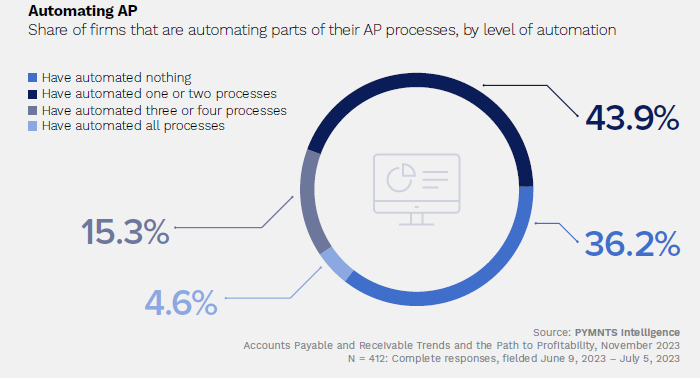Cost Concerns Keep More Than One-Third of Firms From Automating AR Processes

Businesses expect that handling payments — both sending and receiving them — will become even more crucial in the future.
On average, companies anticipate a 50% increase in payments made and a 46% surge in the number of invoices dispatched in the upcoming three years. Among those surveyed in a recent PYMNTS Intelligence study, nearly 80% predict a rise in the quantity of payments processed via their accounts payable (AP) systems, while 75% foresee an increase in the volume of invoices received through their accounts receivable (AR) systems.
This surge in invoicing and payment workload puts businesses employing manual accounting processes at a disadvantage, as it becomes increasingly challenging to handle the growing volume efficiently.
While automation offers numerous benefits, more than one-third of firms have been hesitant to adopt it due to concerns about cost and complexity, as noted in the report, which sheds light on the challenges faced by midsize firms in automating their AR processes.

In fact, despite the advantages of automating AP and AR processes, more than one-third of firms have chosen to postpone implementation due to worries about the cost and complexity involved.
The research indicates that a significant portion of individuals also choose not to upgrade their AP and AR capabilities because their existing systems are equipped to manage the projected increase in payment volumes.
“Seeing no immediate problem, these managers may not be as easily swayed to change the way things are, even given automation’s appealing promises and benefits,” the report explained, adding this reluctance could stem from prior encounters with challenging integrations, expectations of similar obstacles in their current positions, concerns about implementation expenses, or perceptions of complexity associated with automating processes.
However, the report emphasizes that automation is crucial for ensuring timely payments to vendors and suppliers, as well as for expediting the collection of receivables. Moreover, firms that have embraced automation report numerous benefits, including enhanced accuracy, efficiency, and streamlined processes.
More than 70% of businesses also reported that automation leads to improved cash flow, increased savings, and overall business growth. while 75% shared similar sentiments regarding AR automation. “Vendor satisfaction is yet another benefit,” the report added, “as 31% to 41% of executives surveyed identified increased vendor satisfaction as a benefit that automation brings to their firms.”
In sum, the report underscores the importance of automating AP and AR processes for midsize firms. While cost concerns may deter some firms from adopting automation, the benefits of increased efficiency, accuracy, and improved cash flow make it a worthwhile investment.
Automation partners and technology providers can play a crucial role in addressing firms’ concerns and supporting them throughout the integration process, fostering a more widespread adoption of this transformative technology.

